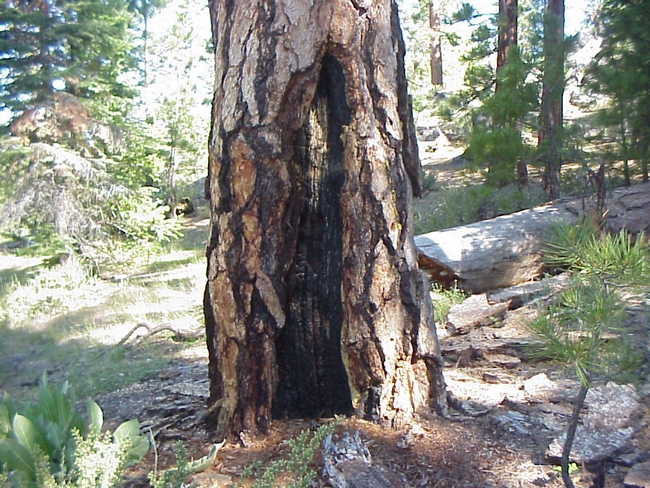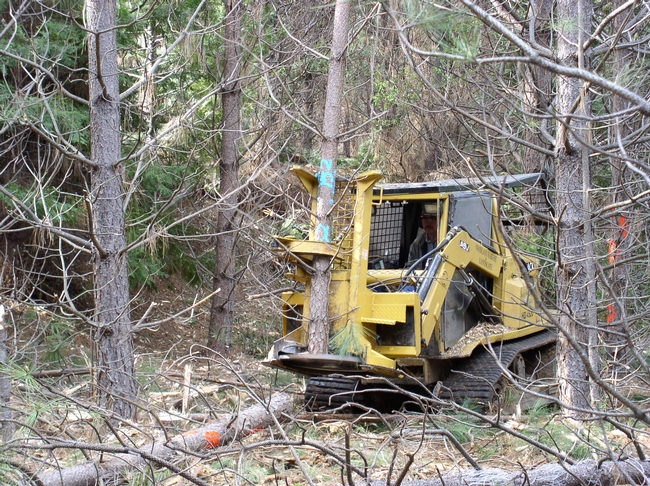A new review of recent research found that fuels reduction involving small tree and fuel removal and prescribed burning creates more fire resistant forests without causing long-term harm to other resources. Scott Stephens, University of California associate professor, led a review team that published the paper, “The Effects of Forest Fuel-Reduction Treatments in the United States”, in the June 2012 edition of the journal BioScience.

One hundred years of fire suppression, along with removal of large trees during logging, has created more crowded forests with more fire susceptible trees. This has led to wildfires that are larger and more intense, often killing most of the trees over large areas.
Researchers found that forest fuel reduction, using prescribed fire and ‘mechanical treatments’ which involve removing small trees with heavy equipment and/or grinding up small trees and shrubs, is generally effective at reducing fire intensity and improving tree health without negative effects on understory vegetation, soil density or erosion, wildlife or carbon storage. However, effects vary by resource and treatment type.
Fuels and fire behavior:
Prescribed fire is most effective at reducing surface fuels including downed wood, litter such as pine needles, and shrubs. The disadvantage of using prescribed fire alone is that trees killed by the fire are left standing to eventually fall and contribute to future fire risk. Using both prescribed fire and mechanical treatments is most effective at reducing high intensity crown fires because tall shrubs and intermediate size trees that act as the ladders to carry fire into the forest canopy are also removed.
The effectiveness of mechanical thinning alone is largely dependent on the type of harvest system used and whether it leaves logging debris in the treated stand. Whole tree harvesting is most effective because limbs and other debris are removed that would otherwise become fuel on the forest floor.
Both prescribed fire and mechanical treatments may cause short-term increases in mortality of remaining trees when bark beetles colonize injured trees and dead material left on the forest floor. However the mortality rate is generally less than 5% and is concentrated in smaller trees, though occasionally larger trees may die later. However, forest treatments reduce forest susceptibility to bark beetles in the long term. Research in the Sierra Nevada showed that 80% of all trees killed by bark beetles die in the first two years after treatment. And in nearby untreated areas, bark beetles also kill trees because trees are overcrowded and stressed.
Vegetation:
Prescribed fire is most effective at killing fire sensitive species and cueing seed germination of fire dependent species. Mechanical treatments open the forest canopy, provide increased sunlight and so increase plant production and diversity of plants on the forest floor. However treatments that leave a large amount of woody debris may inhibit understory vegetation. Both fire and mechanical treatments may increase abundance of exotic species.
Soil:

Wildlife:
Treatments have the potential to create forests with structure and habitat conditions favored by many wildlife species in the short term. Depending on treatment type, between a quarter and a half of bird and small mammal species have positive responses while 5% to 44% have negative responses, respectively. The rest have no response at all. Thinning alone may adequately mimic low-severity fire effects on birds and mammals in areas where prescribed fires are hard to implement. However, treatments do not create conditions suitable for all species especially those that require early successional habitat created by patches of high severity fire.
Carbon:
Forests store carbon in the soil, litter and dead wood, and in standing trees. Prescribed fire reduces carbon on the forest floor but only in the short-term. Mechanical treatments significantly reduce carbon stored in vegetation though about a third is recovered within three years after treatment. Combined treatments reduce carbon both in vegetation and on the forest floor. None of the treatments affect stored carbon in the soil.
Forest fuel treatments cost from hundreds to thousands of dollars per acre depending on method, material to be removed, terrain, and location. Prescribed fire is a relatively inexpensive way to reduce surface and ladder fuels. Mechanical treatments are generally more expensive though the small and intermediate trees removed can produce wood products such as sawlogs or biomass chips to offset treatment costs. This is highly dependent however, on the proximity of the site to a sawmill or biomass facility since the cost of transporting chips and logs is relatively high. Any cost comparison of fuel reduction treatments should include a comparison of costs associated with wildfire including loss of forest products, habitat, water and other values, and the cost of fire suppression.
Recommendations:
The authors recommend that managers use a variety of methods including prescribed fire, mechanical thinning, and managed wildfire to meet their fuels objectives and create heterogeneity in the forest landscape. Though mechanical treatments do not serve all the ecological functions of fire, they can help reduce treatment costs and reduce risks in areas near communities. The goal of fuels treatments should not be to eliminate all high-severity fire, but rather to contain high severity patches to relatively small areas.

